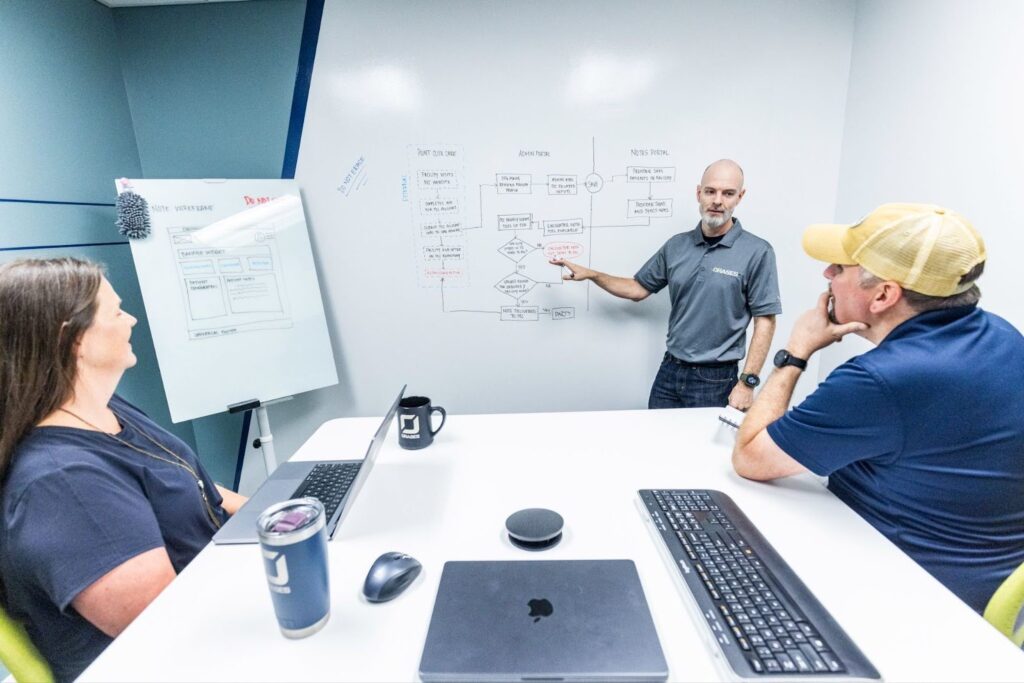Framework For Successful AI Integration In Healthcare
Learn how AI agents are transforming enterprise operations and get a strategic roadmap for successful implementation across your organization.

Artificial Intelligence (AI) is actively transforming and reshaping healthcare as we know it, offering promising pathways toward improved diagnostic precision, optimized workflows, better patient monitoring, and substantial cost reductions.
Healthcare organizations of all sizes are currently standing at the threshold of considerable technological advancement, yet integrating AI effectively demands thorough preparation and careful attention to clinical, technical, and ethical dimensions.
A detailed, structured framework is therefore necessary to implement AI successfully, as it must systematically address strategic alignment, data infrastructure, compliance with regulatory standards such as HIPAA, and meticulous validation of solutions to safeguard patient outcomes and data security.
Healthcare leaders should align their AI strategies clearly with overarching patient-care objectives, laying the groundwork through governance structures that include clinicians, technical specialists, and compliance experts.
Establishing an AI governance committee within organizations has become best practice; these committees oversee implementation from project inception through ongoing monitoring, with diverse stakeholder involvement to minimize clinical and ethical risks.
In addition to this, healthcare providers must thoroughly evaluate their current data quality, infrastructure, and interoperability capabilities, preparing these foundational elements for the demanding computational and integration requirements of AI tools.
Successful adoption further depends upon clinical integration and diligent change management, which involve targeted training, user-centered workflow design, and transparent communication strategies that address staff readiness and patient awareness.
Throughout integration and beyond, continuous monitoring and refinement processes are necessary, allowing organizations to respond proactively to shifting needs, maintain performance standards, and realize sustained benefits from AI integration into healthcare solutions.
01
Chapter 01
Creating the Foundation for Healthcare AI Integration
Successful AI implementation in healthcare demands careful consideration of an organization’s current state, capabilities, and overall readiness. Healthcare institutions must carefully assess their technical infrastructures, data management practices, and internal workflows at depth before integrating AI technologies into their operations.
The various parties involved, including clinical teams, administrators, and patients, play substantial roles; alignment and preparation among these groups form the foundation for meaningful and effective AI solutions.
Current State Analysis & Infrastructure Evaluation
Healthcare organizations intending to adopt AI effectively must start by systematically evaluating their current operational, technological, and clinical infrastructures. These types of evaluations involve detailed analyses of existing capabilities and processes to identify gaps, establish accurate implementation baselines, and determine necessary enhancements.
Recognizing areas for improvement before AI integration helps reduce potential implementation challenges, aligning the technology more closely with organizational needs and objectives.
Technical Infrastructure & System Capabilities Assessment

A foundational step toward integrating AI in healthcare involves assessing existing technical infrastructure in an in-depth manner. Healthcare institutions need to understand whether their current IT systems, such as electronic health records (EHRs), laboratory information systems, imaging archives, and network capabilities, can support advanced AI applications.
Evaluations should closely examine processing power, the availability of graphic processing units (GPUs) for model training and real-time data analysis, cloud or on-premises computing capabilities, and data storage adequacy. To allow for seamless data sharing across varied platforms and AI tools, healthcare IT departments must adopt interoperability standards like Health Level Seven (HL7) and Fast Healthcare Interoperability Resources (FHIR).
Having an in-depth understanding of these technical aspects helps healthcare organizations accurately anticipate infrastructure upgrades needed to handle AI workloads. AI integration efforts might reveal the necessity of expanding server capacity, enhancing data storage solutions, or improving network reliability.
Identifying these infrastructure gaps in advance significantly reduces disruptions during deployment, positioning organizations to manage computational demands effectively.
Healthcare Data Quality & Standardization Analysis
Data quality directly impacts the effectiveness and accuracy of AI solutions that are deployed within healthcare environments. Organizations must evaluate the completeness, integrity, and standardization of their clinical and operational data thoroughly before adopting AI technologies.
Clinical data frequently contains inconsistencies, errors, or missing values, potentially compromising AI model performance and reliability. Such challenges emphasize the importance of structured data quality assessments, which involve systematic checks for inaccuracies, duplications, and incomplete records.

Healthcare organizations can adopt protocols and technologies designed for data cleaning, standardization, and normalization. Using large, standardized datasets enables the training of accurate and unbiased AI models, improving their effectiveness across diverse patient populations.
For instance, the UK’s National Health Service (NHS) demonstrated the significant predictive capability of hospital data after standardizing and anonymizing 460,000 patient records, effectively enhancing their capacity to accurately forecast patient length-of-stay outcomes.
Standardizing terminology across various systems, such as using universally recognized clinical terminologies like SNOMED-CT and ICD-10, strengthens data interoperability and facilitates consistent AI model training. Structured data governance frameworks further control data access, usage, and security, aligning AI efforts with regulatory compliance and ethical standards.
Clinical Workflow & Process Documentation
Systematic documentation of current clinical workflows forms an integral step toward AI readiness, helping healthcare providers pinpoint processes ripe for AI enhancement.
Mapping clinical workflows reveals inefficiencies, redundancies, or resource-intensive tasks suitable for automation or AI-driven optimization. Documenting detailed patient journeys, from registration through diagnosis, treatment, and follow-up care, allows institutions to visualize clearly how AI can enhance efficiency and patient care quality.
For example, many healthcare institutions identify physician documentation and patient scheduling as tasks where AI can significantly reduce clinician burden and streamline operations. Clearly documented workflows provide a baseline for assessing improvements after AI integration, facilitating precise performance monitoring.
Workflow maps developed collaboratively with frontline clinicians capture realistic scenarios, challenges, and opportunities, informing better integration strategies. Such collaborative efforts often result in higher clinician engagement and acceptance of AI tools.
Organizational Readiness & Stakeholder Alignment
Evaluating an organization’s readiness for an array of parties, including clinical staff, administrative leaders, and patients, is essential for the successful adoption of AI in healthcare.
Assessing and building readiness requires deliberate alignment of technology initiatives with strategic organizational objectives, clear communication strategies, and customized training programs. Each stakeholder group’s preparedness and support significantly influence the overall adoption and effectiveness of AI solutions.
Clinical Team Preparation & Change Management
The readiness of clinical teams significantly influences AI adoption success, highlighting the necessity of targeted evaluations and training initiatives.
Healthcare organizations must assess clinical staff comfort levels, knowledge, and skills regarding new technologies before integrating AI. Identifying potential resistance or concerns through surveys, interviews, and direct engagement provides actionable insights for addressing apprehension effectively.
Training programs that are carefully customized specifically toward clinical roles, including physicians, nurses, and allied health professionals, can considerably boost AI adoption rates. Simulation labs or hands-on sessions enable staff to familiarize themselves safely and comfortably with AI-driven processes.
Clinicians typically respond positively when they witness practical benefits, such as AI-supported diagnostics or automated documentation reducing administrative burdens.
Successful organizations continuously support clinicians through refresher training and clear documentation on AI system usage and limitations. Appointing internal champions or super-users to guide their colleagues further enhances confidence and engagement with AI solutions. Addressing clinician concerns proactively helps build trust and facilitates smoother transition processes.
Leadership Engagement & Strategic Alignment

Strong executive support significantly enhances the likelihood of successful AI integration in healthcare organizations.
Leadership teams must actively engage in AI initiatives from early stages, setting strategic objectives and clearly communicating their vision throughout the organization. Aligning AI projects directly with overarching goals such as improving patient outcomes, operational efficiency, and care quality helps reinforce AI’s strategic value within the organization.
Healthcare executives increasingly designate dedicated roles, such as Chief AI Officers or AI governance committees, to oversee AI implementation projects. These leaders provide strategic direction, policy guidance, and monitoring throughout AI system lifecycles. Effective leadership engagement establishes clear accountability frameworks, promoting transparency, trust, and systematic oversight across AI-driven initiatives.
Frequent updates, transparent communication, and clear articulation of AI’s benefits, such as improved patient satisfaction or operational efficiency, further demonstrate executive commitment, encouraging broader organizational support. Leadership engagement significantly influences resource allocation decisions and creates a culture embracing innovation, continuous improvement, and adaptive learning.
Patient Communication & Engagement Strategy
Patient awareness and acceptance represent important dimensions of successful AI integration in healthcare.
Effective patient communication strategies require clear explanations of how AI systems contribute to improved healthcare outcomes, personal data security measures, and informed consent protocols. Patients need transparency regarding AI use within their care, including details on how personal data is handled and secured, and opportunities to address any questions or concerns.
Developing straightforward patient education materials, such as pamphlets, websites, or explanatory videos, helps clarify AI’s role within clinical processes. Healthcare organizations must explain clearly how AI enhances diagnostic accuracy or patient monitoring, emphasizing patient benefits, improved healthcare experiences, and personalized care approaches.
Implementing consent processes, compliant with regulatory standards such as HIPAA, GDPR, and other privacy laws, is necessary when involving patient data in AI projects. Healthcare providers should maintain openness about AI-assisted care delivery, building greater trust between patients and clinical teams. Such transparent approaches contribute positively toward patient acceptance, satisfaction, and ongoing engagement with healthcare providers.
Regularly soliciting patient feedback through surveys or informal discussions helps healthcare organizations address patient concerns promptly and adjust communication strategies as necessary. Incorporating patient perspectives reinforces ethical considerations within AI implementation projects, promoting equitable, responsible, and patient-centered healthcare solutions.
A carefully structured approach to evaluating technical infrastructures, data quality, clinical workflows, organizational readiness, leadership alignment, and patient engagement significantly enhances healthcare organizations’ preparedness for AI integration.
Organizations implementing these detailed assessments proactively build a stable foundation, facilitating smoother integration and effective long-term AI usage, ultimately improving patient outcomes and organizational efficiency.ute environments, are in a stronger position to expand and adapt to new use cases. The more departments are connected through agentic automation, the greater the organizational return.
02
Chapter 02
Technical Architecture & Integration Framework Development
Effectively integrating AI within healthcare requires thoughtful consideration of technical architecture and connectivity to existing systems.

Healthcare organizations aiming to adopt AI successfully must carefully plan technical frameworks, interoperability solutions, and secure data handling practices. Establishing these foundational elements supports seamless integration, enhances clinical operations, and addresses stringent regulatory requirements within the healthcare environment.
A strong AI technical architecture must begin with a clear understanding of the organization’s current IT ecosystem, which includes mapping all clinical and operational systems, identifying data sources, and closely evaluating infrastructure capabilities such as computing power, storage, and network reliability.
AI systems often require high-performance computing resources for model training and inference, particularly in applications involving imaging or large-scale natural language processing. Therefore, decisions around on-premise infrastructure versus cloud-based deployment must be made early on, carefully weighing performance needs, latency, and data residency considerations.
On top of this, AI integration requires a modular and service-oriented architecture that supports flexibility and scalability. Modular systems allow new AI components to be added or replaced without overhauling existing platforms, reducing development time and risk.
Elements such as microservices, containerization, and API-driven design are commonly used to maintain agility and interoperability across diverse health IT environments.
Organizations must also address data readiness, as many healthcare datasets are fragmented, unstructured, or siloed across different departments.
Establishing a unified data architecture that supports standardized data models and consistent data formatting is fundamental, which can include implementing data lakes or data warehouses that centralize inputs from EHRs, lab systems, imaging repositories, and patient monitoring devices. Structured pipelines and metadata management tools help track lineage, versioning, and context for each dataset used in AI development or inference.
Finally, AI architecture planning must carefully consider factors including system monitoring, governance, and lifecycle management. Continuous performance tracking, fail-safes, and version control mechanisms are essential to maintain greater reliability, minimize errors, and comply with all clinical safety standards.
System Integration & Interoperability Planning
Effective system integration significantly impacts successful AI deployments in healthcare, influencing operational efficiency and clinical acceptance.
Healthcare providers must design clear, efficient connections between new AI applications and current technology infrastructures to maintain data continuity and streamline clinical workflows. Integration planning involves examining existing system compatibility, assessing data-sharing standards, and designing solutions that support frictionless information exchange.
Clear alignment with interoperability standards remains essential in integrating AI solutions into existing healthcare ecosystems.
Current standards such as HL7 and FHIR facilitate consistent and secure data exchange among EHRs, diagnostic systems, laboratories, imaging technologies, and administrative platforms. Utilizing these established standards simplifies the integration process and reduces implementation timelines, providing clinical teams with reliable, accessible AI-enhanced tools.
Healthcare organizations frequently encounter challenges when attempting to integrate disparate technologies with varying capabilities and standards. To mitigate these difficulties, technical planning should include detailed mapping of data exchanges and integration points so that all required information flows smoothly and securely among systems.
Integration plans help healthcare organizations address challenges proactively, reducing risk and potential added complexity during AI implementation projects.
Electronic Health Record Integration & Data Flow

Connecting AI solutions directly with EHRs is among the most significant technical steps in integrating advanced technologies into healthcare environments.
Healthcare providers must implement secure, reliable connections enabling seamless data transfer between AI applications and clinical databases. Proper integration provides clinicians with timely access to AI-derived insights directly within the familiar interfaces they use daily, improving usability and workflow efficiency.
Creating effective connections involves assessing the capabilities of existing EHR platforms thoroughly. Healthcare IT teams evaluate EHR application programming interfaces (APIs) and integration protocols to determine compatibility with incoming AI systems.
Leveraging standardized integration frameworks like FHIR enables efficient, standardized data sharing while minimizing complexity in interface development. Effective data integration allows AI-generated recommendations and alerts to appear promptly within clinical workflows, significantly improving clinical responsiveness and decision-making processes.
Establishing secure data flows requires healthcare providers to prioritize data encryption, validation, and confidentiality across transmission points. The goal is to transmit and store sensitive patient information securely, maintaining compliance with healthcare regulations such as HIPAA.
Carefully planned data flows prevent interruptions or security vulnerabilities, allowing clinicians to depend confidently on AI-enhanced functionalities embedded within their EHR systems.
Clinical Decision Support System Architecture
Healthcare organizations implementing AI-enhanced clinical decision support systems (CDSS) require thoughtfully designed architectural frameworks supporting clinical efficiency, safety, and reliability.
Architectural planning should prioritize the effective integration of decision-support tools within existing clinical workflows, minimizing disruption while maximizing clinical utility. Healthcare providers designing these systems must emphasize transparency, performance, and ease of clinician interaction to optimize acceptance and usability.
Effective clinical decision-support architectures incorporate detailed considerations of user interfaces, alert generation mechanisms, and informational clarity for healthcare providers. AI-driven recommendations should integrate directly within clinicians’ existing electronic workflow interfaces to maintain simplicity and minimize cognitive burdens.
For example, if an AI solution identifies patients at risk for clinical deterioration, alerts must be integrated within regularly monitored dashboards or pager systems, allowing rapid response from care teams.
Clear logic frameworks should support all AI-generated recommendations, including explanations or confidence scores for clinical review. Providing context for AI suggestions further builds clinician trust and facilitates informed decision-making, enabling healthcare professionals to evaluate AI-generated insights alongside their clinical judgment.
Clinical decision-support architectures require flexibility and scalability, allowing organizations to expand AI functionalities over time without extensive redevelopment. Adopting modular or microservices-based designs supports incremental expansion and straightforward integration of new AI tools as clinical requirements shift.
Scalable architectures help organizations respond quickly to emerging clinical needs or technological advancements, maintaining continuous improvement in patient care delivery.
Data Pipeline & Processing Management

Implementing AI within healthcare depends heavily on efficient, secure data pipelines capable of managing large-scale clinical data securely and reliably. Healthcare organizations must develop structured, high-performing data pipelines, allowing seamless data transfers between systems, consistent data quality management, and compliance with strict healthcare data regulations.
Effective data pipeline management starts with identifying data sources clearly and precisely, establishing data extraction, transformation, and loading (ETL) processes carefully.
ETL processes standardize data formats, cleanse inaccurate information, and anonymize protected patient details where required. Healthcare providers must maintain the reliable operation of these pipelines, addressing potential bottlenecks proactively and preventing data loss or corruption risks.
Managing data pipelines requires continuous monitoring, strong error-handling procedures, and automated quality assurance checks. Implementing real-time monitoring dashboards allows healthcare IT teams to track data flows actively, detecting and resolving irregularities quickly.
The use of efficient data management cuts down on system downtime and supports consistently high AI application performance, directly benefiting clinical care.
Healthcare organizations also implement powerful data security measures throughout pipeline processes, protecting sensitive patient information. Practices include encryption during data transfer and storage, strict access controls, and detailed auditing procedures.
Maintaining stringent pipeline management standards helps healthcare providers safeguard data integrity, comply with healthcare privacy regulations, and build clinician and patient trust in AI systems.
Healthcare Security & Compliance Framework
Healthcare organizations integrating AI technologies have to deal with stringent security and compliance obligations due to handling sensitive patient data.
Security and compliance frameworks become central components of AI technical architecture development, protecting patient privacy, maintaining regulatory compliance, and safeguarding organizational reputation. Having clearly defined compliance measures in place helps build clinician and patient confidence, supporting broader adoption and acceptance of AI solutions.
HIPAA Compliance & Protected Health Information Management
HIPAA compliance is non-negotiable for healthcare AI systems that store, process, or transmit patient health information within U.S. jurisdictions.
Healthcare providers must integrate rigorous HIPAA-compliant practices into AI solution architectures, addressing data privacy, security, and breach prevention. Integrating strict compliance measures supports patient trust, mitigates legal risks, and enhances overall solution effectiveness.
Healthcare organizations adopting AI must implement encryption protocols rigorously for data transmission and storage, addressing HIPAA’s security requirements explicitly. All third-party AI service providers handling patient data should sign HIPAA-compliant business associate agreements clearly defining roles, responsibilities, and accountability in maintaining patient data privacy and security.
Healthcare providers frequently utilize secure “AI sandbox” environments, enabling authorized personnel to develop, test, and validate AI models safely, maintaining strict compliance with HIPAA and other applicable regulations.
Secure sandboxes allow healthcare researchers and technical teams to innovate responsibly without compromising sensitive patient information. These controlled environments support healthcare innovation while minimizing compliance-related risks effectively.
Access Control & Authentication Systems
Controlling access to sensitive healthcare information forms a foundational element of effective AI integration, addressing regulatory requirements and protecting patient privacy.

Role-based access control (RBAC) policies must be carefully designed to make sure that only authorized personnel access sensitive data, and only in contexts relevant to their duties. RBAC systems provide flexible yet secure access to AI-generated insights, minimizing unauthorized usage risks significantly.
Implementing strong authentication mechanisms further supports access control efforts. Healthcare providers frequently adopt multi-factor authentication (MFA) procedures to verify user identities effectively before granting system access. MFA actively enhances security substantially by requiring multiple independent credentials, significantly reducing unauthorized access risks and protecting sensitive healthcare data.
Detailed documentation and regularly updated role definitions clarify responsibilities and maintain accountability within healthcare AI applications. Healthcare IT departments are able to keep clear, detailed access control logs recording user interactions and authorization events accurately.
Access controls that are combined with rigorous authentication processes safeguard patient information thoroughly, strengthening healthcare data security significantly.
Audit Trail & Compliance Documentation
Maintaining in-depth audit trails and compliance documentation remains essential in healthcare AI deployments, supporting regulatory compliance, legal protection, and ongoing quality management efforts. Audit trails are able to provide complete records of data usage, user activities, and system modifications within AI applications, clearly documenting accountability and adherence to healthcare regulations and internal policies.
Healthcare organizations implement detailed logging and monitoring systems that capture relevant information continuously, including user logins, data access events, system alerts, and configuration changes. Regularly reviewing audit logs proactively identifies potential issues, unauthorized activities, or operational anomalies promptly, allowing for timely interventions and corrective actions to take place.
Effective audit trail management involves automated monitoring tools generating real-time alerts based on predefined criteria, notifying healthcare IT teams immediately upon detecting unusual patterns or potential security risks. Healthcare providers integrate audit trail information into broader compliance frameworks, regularly reviewing documentation during internal or external audits to verify ongoing regulatory compliance effectively.
Healthcare AI compliance documentation encompasses clear policies detailing system functionalities, data usage guidelines, security procedures, and ethical considerations. Maintaining accurate compliance documentation supports regulatory adherence, facilitates transparency, and reassures clinicians and patients regarding AI system safety, effectiveness, and integrity.
Healthcare organizations adopting thorough approaches to technical architecture planning, system integration, security management, and compliance build stable foundations supporting successful AI deployments effectively.
03
Chapter 03
Clinical Implementation & Workflow Optimization

Effectively incorporating AI into clinical healthcare settings requires thoughtful planning to integrate new technologies into existing workflows seamlessly. As they adopt new technologies, healthcare organizations must strike a balance between innovation, clinical performance, patient safety, and overall operational integrity.
To achieve meaningful outcomes from AI, providers must thoroughly evaluate clinical processes, adapt workflows carefully, automate suitable tasks, and thoughtfully manage the organizational changes necessary to support the adoption of these technologies across clinical teams.
Successful clinical implementation of AI depends substantially on proactive evaluation and preparation, emphasizing clinician engagement from the earliest stages of planning.
Healthcare providers need to engage frontline clinical staff directly to identify practical pain points and inefficiencies within their daily routines, clarifying precisely how AI could best support existing care processes without causing unnecessary disruptions or workflow complexity.
Properly understanding clinical concerns early allows organizations to customize AI systems more closely to real-world needs, ultimately boosting adoption and enhancing satisfaction among clinicians.
Healthcare leaders must communicate openly and frequently with staff about AI implementation goals, timelines, and expected clinical benefits. Transparent communication helps address potential fears or misconceptions clinicians may harbor regarding technology replacing human judgment.
Clearly framing AI as a supportive tool designed explicitly to reduce burdens, improve diagnostic accuracy, and enhance patient outcomes promotes positive perceptions among clinicians, facilitating smoother transitions and greater acceptance.
Healthcare organizations should also emphasize user-centered design principles throughout AI integration projects. Prioritizing ease of use and intuitive interfaces significantly improves clinician interaction with AI tools, reducing cognitive load and minimizing workflow disruptions.
AI integration becomes more effective when clinical teams find tools genuinely helpful, straightforward, and naturally embedded within familiar systems.
Thoughtful design and iterative testing involving clinical users directly contribute to higher adoption rates, greater satisfaction, and sustained clinical benefits from AI-driven enhancements within healthcare delivery.
Clinical Process Enhancement & Automation

AI offers significant opportunities for enhancing clinical processes through targeted automation and workflow improvement.
When identifying potential enhancements, healthcare providers should evaluate existing clinical workflows in detail to pinpoint tasks that could benefit from AI-driven support. Such tasks involve repetitive administrative duties, data analysis, clinical documentation, and patient monitoring activities, all of which can consume considerable clinical staff time and resources.
Mapping clinical processes provides clarity around how AI solutions can augment the efficiency and accuracy of healthcare delivery.
For instance, evaluating current patient admission and discharge procedures may reveal administrative bottlenecks that AI-powered scheduling or predictive tools can effectively alleviate. AI algorithms predicting patient length of stay or readmission risks allow clinicians to proactively manage patient care transitions and resource allocation, potentially reducing hospital stays and associated costs.
Clinical process enhancement through automation extends beyond administrative tasks to include clinical decision-making support. Advanced AI systems analyzing diagnostic images or clinical laboratory results enhance diagnostic accuracy and speed, enabling quicker intervention and treatment initiation.
Early identification of high-risk patients through predictive modeling permits targeted interventions to reduce preventable complications, hospitalizations, and associated healthcare expenditures.
Healthcare institutions integrating AI must carefully assess the feasibility of proposed enhancements, considering technical, clinical, and ethical factors. Organizations should implement pilot projects initially to validate AI-driven enhancements before broader deployment, allowing clinicians to evaluate performance in realistic clinical scenarios.
Piloting AI solutions also supports fine-tuning to address workflow integration issues or performance concerns identified by clinical staff, ultimately contributing to higher adoption and satisfaction rates.
Workflow Adaptation & Clinical Integration
Effective AI integration requires careful adjustments to existing clinical workflows, allowing for minimal disruption while maximizing clinical value. Adapting workflows involves modifying steps, processes, and interfaces to accommodate AI-driven tools seamlessly within the routine clinical activities of healthcare providers.
Organizations must thoroughly document current workflows to identify precisely where and how AI interventions can fit naturally without complicating existing procedures or adding cognitive burdens.
Healthcare organizations should integrate AI outputs directly into systems clinicians already use, such as EHRs, diagnostic imaging viewers, or patient monitoring dashboards.
For example, integrating AI-generated patient deterioration alerts within EHR dashboards that clinicians regularly review helps streamline response times without adding extra steps or new applications. Clinicians more readily accept technologies that smoothly enhance existing routines rather than disrupt them with separate interfaces or cumbersome procedures.
Careful consideration should be given to how AI tools present clinical information to users. AI-generated alerts must offer clear, concise information supporting clinical decision-making without overwhelming clinicians or causing alert fatigue.
Organizations integrating AI into clinical workflows should employ iterative pilot testing involving frontline clinical staff, gathering feedback on workflow compatibility while adjusting AI interfaces or outputs based on clinical input.
Clear communication of workflow changes to clinicians forms an essential component of successful AI integration. Healthcare organizations should provide thorough documentation outlining new workflow procedures, user roles, and expectations related to AI tools, helping clinical staff quickly adapt to updated practices.
Open communication channels allow clinical staff to address concerns promptly and seek clarification when necessary, supporting smoother transitions and higher acceptance rates.
Task Automation & Efficiency Optimization

AI-driven task automation significantly impacts clinical efficiency, allowing healthcare providers to redirect time previously spent on routine or administrative tasks toward direct patient care.
Automating repetitive clinical tasks can reduce clinician workload substantially, mitigate burnout, and enhance overall clinical efficiency. Examples of automatable tasks include clinical documentation, patient scheduling, administrative data entry, and repetitive monitoring or reporting duties.
One area with substantial automation potential involves clinical documentation. Healthcare providers frequently report significant burdens associated with documentation responsibilities, which often extend beyond patient care hours.
Ambient AI documentation tools, which automatically transcribe patient interactions and generate clinical notes, greatly reduce manual documentation time, allowing clinicians to focus more directly on patient interaction and care quality.
Healthcare providers must carefully balance automation with appropriate clinical oversight, maintaining accountability for clinical decisions and patient safety.
AI-driven automation should assist clinicians rather than replace their judgment, clearly distinguishing between routine tasks suitable for automation and clinical decision-making tasks requiring careful human oversight. Automated systems performing patient triage, for example, must clearly indicate decision criteria and confidence levels, enabling clinicians to intervene quickly when necessary.
When introducing automated tasks, healthcare organizations should assess the impact regularly to optimize efficiency and maintain patient safety.
The continuous monitoring and evaluation of automated tasks help identify unexpected outcomes or inefficiencies quickly, allowing rapid adjustments or refinements. Iterative improvement based on clinical feedback supports sustained efficiency gains and strengthens clinician trust in AI-driven automation capabilities.
Change Management & Clinical Adoption
Effective adoption of AI technologies within healthcare requires change management strategies that address staff preparation, training, and ongoing support. Transitioning clinical staff to new technological workflows presents numerous challenges, necessitating deliberate planning and proactive communication efforts.
Healthcare organizations must approach AI integration collaboratively, providing resources, training, and continuous engagement to facilitate widespread clinical adoption and achieve intended clinical outcomes.
Clinical Training & Support Programs
Thorough training programs can significantly contribute to successful AI adoption by preparing clinical staff thoroughly for the upcoming changes in their workflow and practice.
Healthcare providers integrating AI solutions must develop targeted training programs addressing specific roles and responsibilities, making sure that clinicians clearly understand AI tool functions, limitations, and appropriate usage practices. Employing effective training cuts down on clinical apprehension, increases user confidence, and encourages early adoption and consistent utilization of AI tools within clinical workflows.
Healthcare organizations should deliver their training through multiple methods, including formal classroom sessions, practical simulations, hybrid courses, and online modules accessible anytime.
Simulations or hands-on practice opportunities allow clinical staff to familiarize themselves with AI tools safely, building proficiency and confidence before real-world application. Training should explicitly demonstrate how AI integration enhances clinical workflows and patient outcomes, clearly communicating benefits to encourage clinician buy-in and enthusiasm.
Clinical staff should have continuous access to support resources, such as reference documentation, helpdesk services, and internal AI experts or champions available to assist colleagues during the integration process.
Periodic refresher sessions addressing AI system updates or enhancements help maintain clinical proficiency and reduce knowledge gaps over time. Healthcare organizations prioritizing continuous education and readily accessible support achieve smoother transitions, higher adoption rates, and sustained clinical satisfaction.
Healthcare leaders should actively engage clinical staff during training development, seeking feedback and recommendations for improvement. Collaborative development of training resources makes sure that content aligns closely with clinical needs and perspectives, further promoting broader acceptance and improving effectiveness.
Encouraging clinical input during training development demonstrates organizational commitment to clinician involvement and satisfaction throughout AI implementation projects.
Feedback Collection & Implementation Adjustment

Continuous feedback collection forms an essential component of successful AI integration, allowing healthcare organizations to identify implementation issues and improvement opportunities proactively.
Feedback systems enable clinical staff to voice concerns, suggest adjustments, and highlight areas needing attention, creating a collaborative approach to technological integration and workflow optimization. Healthcare organizations must create structured feedback mechanisms encouraging honest, constructive input from clinical users to support continuous improvement and sustain long-term adoption success.
Healthcare providers should utilize various feedback collection methods, such as surveys, direct interviews, and regular group meetings, allowing clinical staff to share experiences openly.
Organizations benefit from actively soliciting detailed feedback regarding AI system performance, workflow integration effectiveness, usability issues, and training adequacy. Clinical staff should understand how their input directly contributes to improvements, motivating continued participation in feedback processes.
Healthcare organizations analyzing clinical feedback systematically can identify patterns, trends, or recurring issues quickly, facilitating targeted adjustments or refinements.
Clinical input helps prioritize which improvements require immediate attention versus those suitable for longer-term consideration, focusing organizational efforts effectively. Addressing user-identified issues promptly reinforces clinical trust in AI integration processes, demonstrating organizational responsiveness and commitment to clinician satisfaction.
Clinical leaders should communicate feedback-driven improvements transparently, clearly illustrating how clinical input influenced adjustments or enhancements. Highlighting clinician contributions publicly boosts engagement, demonstrates appreciation, and encourages continued active participation in ongoing feedback processes.
Healthcare providers prioritizing transparent, responsive feedback mechanisms achieve stronger clinical engagement, smoother AI adoption experiences, and improved long-term clinical outcomes. Integrating AI capabilities effectively within clinical healthcare workflows requires proper planning, clear communication, deliberate workflow adaptations, and proactive organizational support.
Through systematic process evaluation, workflow adaptation, responsible automation, and structured change management, healthcare organizations better position themselves for effective AI adoption. Adopting this approach drives long-term performance and enhances both provider satisfaction and patient care quality.
04
Chapter 04
Performance Monitoring & Quality Management
Establishing detailed metrics and consistent monitoring protocols represents a foundational element of successfully integrating AI within healthcare.
Healthcare organizations must track their AI performance systematically, utilizing clearly defined metrics that measure clinical effectiveness, operational efficiency, patient satisfaction, and overall reliability.
Sustained improvement in AI applications depends heavily on continuous quality management processes that support careful, measured refinements over time.
Clinical Outcomes & Performance Metrics

Healthcare providers integrating AI must diligently track the effects of these technologies on clinical performance and patient care delivery.
Establishing precise metrics allows organizations to measure AI effectiveness objectively, quickly identifying improvements or pinpointing challenges that need resolution. Healthcare organizations frequently employ structured dashboards that present AI-generated performance data clearly, enabling clinical staff and administrative teams to review results regularly and act swiftly on emerging trends or issues.
Effective monitoring of clinical outcomes involves defining relevant metrics directly aligned with clinical goals, such as improved diagnostic accuracy, reduced hospital readmissions, shorter length of stay, or enhanced patient safety.
For instance, an AI-powered predictive model aimed at identifying patients at risk of hospital readmission should be evaluated using metrics such as readmission rates, early intervention effectiveness, and subsequent patient health status improvements.
Measuring these outcomes systematically enables organizations to validate AI-driven clinical interventions objectively, maintaining confidence among clinicians and patients alike.
Clinical metrics should be selected collaboratively, engaging frontline clinicians, administrators, and data specialists to capture realistic expectations and meaningful benchmarks. Collaborative metric selection helps organizations establish clinically relevant performance measures directly reflecting provider experiences, patient outcomes, and operational priorities.
Clearly defined metrics provide essential context for ongoing clinical discussions, supporting targeted interventions to enhance AI system performance consistently.
Organizations integrating AI must prioritize transparency when sharing clinical performance data. Sharing clear, actionable insights with clinical staff regularly demonstrates organizational commitment to continuous improvement and open communication.
Regular performance reviews help clinical teams identify opportunities to leverage AI-driven insights for improved patient care further, thereby increasing clinician engagement and reinforcing technology adoption.
Patient Outcome Measurement & Analysis
Monitoring patient outcomes represents an essential aspect of AI integration, directly connecting technological innovations to measurable improvements in patient care quality and satisfaction.
Healthcare organizations must regularly assess patient health indicators, including clinical status improvements, symptom reduction, and overall satisfaction with care delivery that’s improved through AI tools. Outcome measurement provides tangible evidence of AI’s positive contributions to patient care, reassuring both clinicians and patients regarding technology integration effectiveness.
Patient outcomes can be measured using diverse metrics such as patient recovery rates, complication incidences, mortality rates, or quality-of-life improvements following AI-supported interventions.
For instance, AI tools predicting patient deterioration or infection risks can substantially reduce adverse outcomes, reflected clearly in decreased hospital-acquired infection rates or improved patient recovery timelines. Documenting these patient-centered metrics clearly illustrates AI’s beneficial impacts within clinical contexts, supporting continued technology investment and refinement.
Healthcare providers also measure patient satisfaction explicitly, incorporating surveys, structured interviews, or digital feedback mechanisms designed to capture patient perceptions.
Patient feedback often provides valuable insights regarding AI-driven care quality, user experiences, and areas requiring adjustments or enhancements. Organizations should actively solicit and carefully analyze patient feedback, aligning care processes closely with patient expectations and satisfaction standards.
Regularly analyzing patient outcome metrics enables healthcare organizations to refine AI applications continuously. Healthcare teams should review patient outcome data collaboratively, identifying patterns or opportunities for improvement that can directly influence AI implementation strategies.
Ongoing patient outcome analysis encourages proactive adjustments to AI tools, supporting consistently high-quality care delivery and patient satisfaction.
Operational Efficiency & Resource Utilization
Integrating AI into healthcare processes should clearly improve operational efficiency, enabling healthcare providers to utilize resources effectively while maintaining high care quality standards.

Monitoring operational efficiency requires healthcare organizations to measure metrics such as patient throughput, resource allocation efficiency, task automation effectiveness, and overall productivity improvements resulting from AI-supported workflows.
Organizations should clearly define baseline efficiency metrics before AI implementation, providing necessary benchmarks for objectively evaluating subsequent enhancements. Metrics might include reduced appointment wait times, quicker diagnostic processing, decreased length of hospital stays, or streamlined administrative workflows.
For example, implementing AI-powered appointment scheduling systems could significantly reduce administrative burden, clearly reflected in measurable reductions in scheduling errors or quicker appointment confirmations.
Efficient resource utilization represents another important consideration, influencing both cost management and patient care effectiveness. Healthcare organizations should track AI’s impacts on resource consumption metrics, such as bed occupancy rates, staffing allocation efficiency, medical supplies usage, and operational costs per patient episode.
Improved resource utilization directly contributes to reduced costs and more effective clinical management, strengthening organizational efficiency and financial stability.
Keeping a close, ongoing watch on operational efficiency helps healthcare systems stay agile and responsive to emerging challenges. Healthcare providers reviewing efficiency data collaboratively can promptly identify potential inefficiencies or bottlenecks requiring corrective actions.
Clear performance monitoring dashboards support informed decision-making by presenting operational efficiency metrics transparently, facilitating effective interventions that sustain optimal healthcare operations.
Quality Assurance & Continuous Improvement

Integrating AI successfully requires consistent quality assurance practices that maintain high performance standards and reliability. Healthcare organizations must prioritize ongoing assessment, validation, and refinement of AI systems, employing systematic approaches to address emerging challenges proactively.
Continuous improvement processes help sustain confidence in AI technologies among clinicians, administrators, and patients, reinforcing adoption success and long-term clinical effectiveness.
AI Performance Validation & Testing
Validating AI system performance represents a fundamental component of ongoing quality assurance, directly influencing user trust and clinical acceptance. Healthcare organizations should regularly assess AI tool accuracy, reliability, and consistency through structured testing processes, maintaining continued compliance with clinical expectations and safety standards.
Regular validation confirms that AI systems function correctly within dynamic healthcare environments, maintaining high reliability levels necessary for patient safety and effective clinical decision-making.
Healthcare providers must establish systematic validation protocols clearly outlining performance criteria, testing methodologies, and review procedures. Validation processes often include retrospective data analyses comparing AI predictions against actual patient outcomes, as well as prospective clinical trials assessing AI performance in real-time care scenarios.
Thorough validation protocols help healthcare teams confidently deploy AI technologies, knowing systems have undergone rigorous testing and consistently meet established clinical standards.
Continuous validation practices enable organizations to identify system performance changes promptly, addressing potential issues quickly before impacting patient care quality. Healthcare organizations should maintain validation records clearly documenting AI system tests, results, and improvements made over time.
Transparent validation documentation supports regulatory compliance efforts, maintains clinician trust, and clearly illustrates ongoing organizational commitment to reliable AI-driven healthcare delivery.
Process Improvement & Optimization Protocols

Continuous improvement practices significantly enhance AI system effectiveness within healthcare environments, enabling organizations to refine processes proactively based on systematic performance analysis.
Healthcare providers must establish clear improvement protocols supporting regular review of clinical workflows, AI-driven tasks, and performance outcomes. With the right improvement process, teams can keep AI systems running smoothly by finding better ways to work and quickly addressing new problems.
Improvement protocols should clearly outline structured review cycles, defining responsibilities, assessment criteria, and documentation requirements explicitly.
Healthcare teams reviewing performance data collaboratively can quickly pinpoint workflow inefficiencies, user issues, or clinical challenges requiring corrective actions. Structured improvement processes prioritize issues systematically, focusing organizational resources effectively on high-impact enhancements that significantly benefit clinical workflows and patient outcomes.
Healthcare organizations should actively encourage clinical staff involvement during improvement cycles, soliciting frontline input to identify practical adjustments and improve AI tool usability or effectiveness.
Clinicians frequently provide valuable insights regarding workflow integration issues, usability concerns, or training gaps directly impacting AI adoption success. Healthcare providers should transparently communicate improvement actions clearly derived from clinician feedback, reinforcing staff engagement and demonstrating organizational responsiveness clearly.
Implementing continuous improvement protocols systematically supports long-term AI system effectiveness, maintaining clinical confidence and operational excellence.
Healthcare organizations regularly evaluate performance data, refine their processes proactively, and actively engage clinical users to sustain high-quality AI integration, clearly delivering consistent improvements in patient care quality, clinical efficiency, and overall healthcare delivery excellence.rease forecast accuracy, reduce missed targets, and improve organizational coordination.
05
Chapter 05
Risk Management & Contingency Planning
The effective integration of AI within healthcare settings requires careful consideration of potential risks and thorough planning to address unexpected challenges proactively.
AI solutions present an array of opportunities to enhance patient care and streamline operations, yet their introduction also brings new risks related to clinical accuracy, operational continuity, and patient safety.
Healthcare organizations must implement strong risk management frameworks that address clinical and operational vulnerabilities while preparing strong contingency plans to maintain uninterrupted healthcare delivery.
Clinical Risk Assessment & Patient Safety

Evaluating potential risks to patient safety stands among the primary responsibilities healthcare providers must manage when incorporating AI into clinical practice.
Organizations must rigorously assess how AI-driven tools influence patient care, carefully considering both positive impacts and possible unintended consequences. Proactive assessment strategies identify potential hazards early, allowing healthcare teams to address them systematically and maintain high standards of patient safety and care quality.
Healthcare institutions that are adopting AI should perform thorough analyses of clinical scenarios where AI could significantly affect patient outcomes.
For example, organizations deploying AI-driven diagnostic tools must assess risks associated with false positives or false negatives, clearly understanding how misinterpretations could impact clinical decisions and patient health. Detailed risk assessments allow healthcare providers to implement safeguards and clinical oversight measures, effectively minimizing patient harm from potential AI errors or inaccuracies.
Healthcare teams must consistently monitor clinical interactions involving AI, tracking any unexpected patterns, incidents, or adverse patient outcomes closely.
Proactive incident tracking helps identify issues quickly, prompting timely responses and necessary adjustments to prevent patient harm or clinical inaccuracies. Regular clinical risk assessments allow for the continuous refinement of AI applications, promoting safer, more reliable patient care.
A clinical risk assessment depends on insights from a broad group of professionals, including physicians, nurses, pharmacists, and allied health staff. Engaging multidisciplinary teams during risk evaluation processes provides in-depth insights into potential clinical challenges, improving the overall effectiveness of mitigation strategies.
The transparent communication of clinical risk assessment outcomes helps build clinician confidence, clearly demonstrating organizational commitment to patient safety and reliable AI integration.
Patient Safety Protocol Development
Implementing proper safety protocols is essential when integrating AI within patient care practices. Healthcare organizations must develop clearly defined safety measures addressing various scenarios involving AI tools, explicitly outlining responsibilities, clinical actions, and necessary oversight.
Carefully created protocols help guide clinicians systematically through AI-assisted care, minimizing potential confusion and enhancing clinical responsiveness in critical care situations.
Patient safety protocols should explicitly address scenarios where AI-generated recommendations influence patient management decisions.
Healthcare teams must clearly understand when and how to verify AI outputs, particularly when systems suggest high-risk interventions or complex clinical pathways. Protocols often include explicit thresholds triggering clinician review or second opinions, providing additional safeguards against potential AI inaccuracies or inappropriate recommendations.
Healthcare organizations benefit from integrating patient safety protocols directly within existing clinical workflows, clearly communicating safety expectations alongside regular care practices. Seamless integration encourages higher compliance with safety measures among clinical staff, reinforcing consistent adherence to established safety standards.
Protocol training and easily accessible reference documentation further strengthen clinical understanding, promoting widespread adoption of patient safety procedures within AI-assisted clinical workflows.

Healthcare providers should regularly evaluate their patient safety protocols, identifying necessary refinements proactively based on clinical feedback or incident analyses. Continuous protocol improvement supports sustained patient safety enhancements, clearly demonstrating organizational responsiveness and ongoing commitment to patient care excellence.
Effective patient safety protocols significantly mitigate potential clinical risks, thereby improving clinician confidence and patient trust in AI-enhanced healthcare delivery.
Clinical Decision Support Validation
Validating the accuracy and reliability of clinical decision-support tools remains essential to maintain patient safety and clinician trust when integrating AI into healthcare delivery.
Organizations must systematically assess AI-driven recommendations against established clinical standards, clearly confirming that decision-support outputs remain consistently reliable and clinically appropriate. Thorough validation processes help healthcare providers confidently utilize AI recommendations within their daily patient care practices.
Healthcare organizations frequently employ both retrospective and prospective validation methodologies, carefully comparing AI-generated recommendations against historical clinical outcomes and real-time patient care results. Retrospective analyses allow providers to evaluate system performance against known clinical outcomes, revealing areas requiring adjustments or refinements.
Prospective validation involves real-time clinical evaluations, where AI outputs undergo clinician assessment within controlled scenarios to confirm reliability and clinical appropriateness before widespread deployment.
Thorough validation procedures are necessary to confirm that AI systems meet clinical standards, with measured results in areas like sensitivity and specificity. Clinicians require clear, understandable validation results that highlight both strengths and potential limitations of AI-driven recommendations, informing their clinical judgment more effectively.
Transparent validation reporting builds clinician confidence in AI tools, reinforcing their willingness to adopt new technologies and integrate them effectively within clinical practices.
Regular, structured validation cycles should be implemented to continually verify AI tool performance, accounting for changing patient populations, clinical guidelines, or healthcare environments. Continuous validation practices proactively identify potential performance declines or accuracy shifts, prompting timely recalibration or algorithm adjustments.
Healthcare providers maintaining diligent validation practices significantly reduce clinical risks associated with AI, clearly enhancing overall patient safety and clinical care reliability.
Operational Risk & Recovery Planning

Operational risks associated with AI integration include technical failures, system downtime, and potential disruptions to healthcare delivery workflows.
Organizations must proactively identify operational vulnerabilities related to AI implementation and develop structured recovery plans addressing technical contingencies in an in-depth manner. Having effective operational risk management helps healthcare institutions maintain consistent patient care and reliable clinical operations, even when encountering unexpected technological challenges.
Operational risk planning involves collaborative assessments with technical experts, healthcare administrators, and frontline clinicians, providing thorough evaluations of potential disruptions arising from AI system issues.
Assessments should clearly define scenarios, including data loss, network outages, system incompatibilities, and unexpected algorithm failures, detailing potential operational impacts and corresponding mitigation strategies. Thorough operational risk analyses inform proactive contingency planning, clearly guiding organizational responses during technical incidents.
Healthcare providers integrating AI must maintain operational continuity even during system disruptions. Organizations achieve continuity through structured failover systems, reliable backup processes, and clearly documented recovery procedures addressing various operational scenarios.
Effective recovery planning minimizes downtime impacts, maintains patient care continuity, and supports rapid resolution of technical issues, significantly enhancing organizational resilience during unexpected disruptions.
System Redundancy & Failover Protocols
Healthcare organizations must create system redundancy plans to maintain uninterrupted healthcare operations despite technical failures involving AI technologies.
Redundant systems provide reliable backup solutions ready to activate automatically when primary systems encounter performance issues or disruptions. Organizations often employ multiple redundant servers, backup storage solutions, and alternative network paths, significantly enhancing system resilience during technical failures.
Failover protocols explicitly define activation procedures for backup systems, clearly outlining automated triggers or manual intervention steps initiating redundancy measures. Healthcare IT teams implement failover configurations regularly tested through realistic simulations, clearly confirming reliability and rapid activation capabilities during actual disruptions.
Systematic testing verifies the readiness of redundant solutions, enabling healthcare providers to rely confidently on established backup protocols when encountering operational challenges.
Organizations should document redundancy plans clearly, specifying responsible personnel, required technical actions, and communication procedures explicitly. Thorough redundancy documentation supports efficient failover processes during operational disruptions, reducing confusion or response delays significantly.
Clear redundancy communication plans also inform clinical teams regarding expected operational changes, facilitating smoother clinical workflow transitions during technical incidents and reinforcing overall organizational preparedness.
Incident Response & Recovery Procedures
Establishing structured incident response protocols remains essential for addressing and resolving AI-related technical incidents promptly, minimizing operational disruptions within healthcare environments.
Healthcare providers integrating AI must define explicit response procedures clearly outlining incident detection, escalation processes, resolution steps, and communication strategies during any recovery efforts. Carefully created response plans help support rapid, coordinated actions, thereby resolving incidents effectively and maintaining reliable clinical operations throughout disruptions.

Incident response procedures clearly define specific roles and responsibilities for clinical, administrative, and technical staff members, detailing precise steps for incident reporting, initial troubleshooting, and escalation processes.
Healthcare organizations benefit from incident response plans involving dedicated response teams available promptly to address emerging issues, coordinating resolution activities efficiently, and communicating clearly across organizational levels.
Recovery procedures explicitly outline step-by-step actions required to restore normal operations following AI-related incidents, clearly guiding technical recovery activities alongside clinical workflow adjustments.
Organizations often employ detailed recovery checklists confirming completion of essential technical tasks systematically, maintaining accountability and transparency throughout recovery efforts. Structured recovery documentation also facilitates thorough post-incident analyses to identify potential improvement opportunities that prevent similar future disruptions.
Healthcare providers should regularly conduct realistic incident simulations, testing response and recovery procedures in-depth while clearly assessing organizational preparedness and response effectiveness. Regular simulation exercises enhance staff familiarity with response plans, clarify responsibilities during incidents, and reinforce organizational resilience significantly.
Continuous refinement based on simulation insights strengthens incident management capabilities, significantly reducing operational risks associated with AI integration and enhancing long-term healthcare operational stability.
06
Chapter 06
Transform Your Healthcare AI Implementation

Integrating artificial intelligence into healthcare provides tremendous opportunities for improving patient outcomes, streamlining operational workflows, and enhancing clinical effectiveness.
Successfully achieving these benefits depends upon meticulous planning, infrastructure assessments, strategic alignment with clinical goals, and rigorous risk management practices. Your organization’s path toward AI-driven healthcare excellence begins with a clear understanding of your current state, readiness, and the specific steps that are necessary for effective AI integration.
Orases is dedicated to supporting healthcare organizations through every step of the AI implementation process, from initial assessments and strategy development to customized technical integration and clinical workflow optimization.
Our experienced healthcare AI specialists collaborate closely with your clinical, technical, and administrative teams to thoroughly evaluate your organizational readiness, identify ideal opportunities for AI adoption, and design customized implementation plans that align closely with your strategic objectives.
Taking advantage of our deep experience and expertise in healthcare technologies and regulatory compliance, Orases builds an array of customized AI solutions that are specifically suited to your organization’s distinct needs and respective challenges.
Our array of integration services prioritizes patient safety, clinical efficiency, and operational excellence while also proactively addressing serious considerations around data privacy, security, and regulatory compliance. Connect with our specialists today to discover how Orases can empower your healthcare organization through strategic, secure, and seamless AI integration.
Schedule your personalized consultation online now, or call our team directly at 1.301.756.5527 to discuss your organization’s goals. Orases is ready to partner with you, driving your healthcare practice toward a future defined by innovation, improved patient care, and sustained clinical excellence. in these foundational areas increases the chances that agents will deliver accurate results, adapt to business demands, and operate at scale without disruption.
"*" indicates required fields
















